FOR IMMEDIATE RELEASE
ACS News Service Weekly PressPac: April 26, 2017
Longer-lasting pain relief with MOFs
"Encapsulation of Ibuprofen in CD-MOF and Related Bioavailability Studies"
Molecular Pharmaceutics
To treat headaches, back pain or fever, most of us have reached for ibuprofen at one point or another. But we often have to take doses every four to six hours if the pain warrants it. Now scientists are working on a way to package the commonly used drug so it can last longer. Their approach, reported in ACS’ journal Molecular Pharmaceutics, could also be used to deliver other drugs orally that currently can only be taken intravenously.
Recently, scientists have been studying compounds called metal-organic frameworks (MOFs), which are made of metal ions linked to organic ligands, for drug delivery. Active ingredients can be packed inside MOFs, which are porous, and some of them have additional traits such as water solubility that make them good candidates for drug couriers. But few studies have so far investigated whether such MOFs could be used in oral formulations. J. Fraser Stoddart and colleagues wanted to test promising MOFs using ibuprofen as a model drug.
The researchers loaded therapeutically relevant concentrations of ibuprofen into easily prepared, biocompatible MOFs with cyclodextrin and alkali metal cations. Testing in mice showed that the compounds reached the blood stream quickly in about 10 to 20 minutes and lasted twice as long as ibuprofen salts, which are the active ingredient in commercial liquid gel formulations. The researchers say the promising findings suggest that these compounds could take the next step toward commercial development for delivering ibuprofen and potentially other drugs.
The authors acknowledge funding from the Joint Center of Excellence in Integrated Nanosystems at King Abdulaziz City for Science and Technology and Northwestern University, and the National Cancer Institute.


